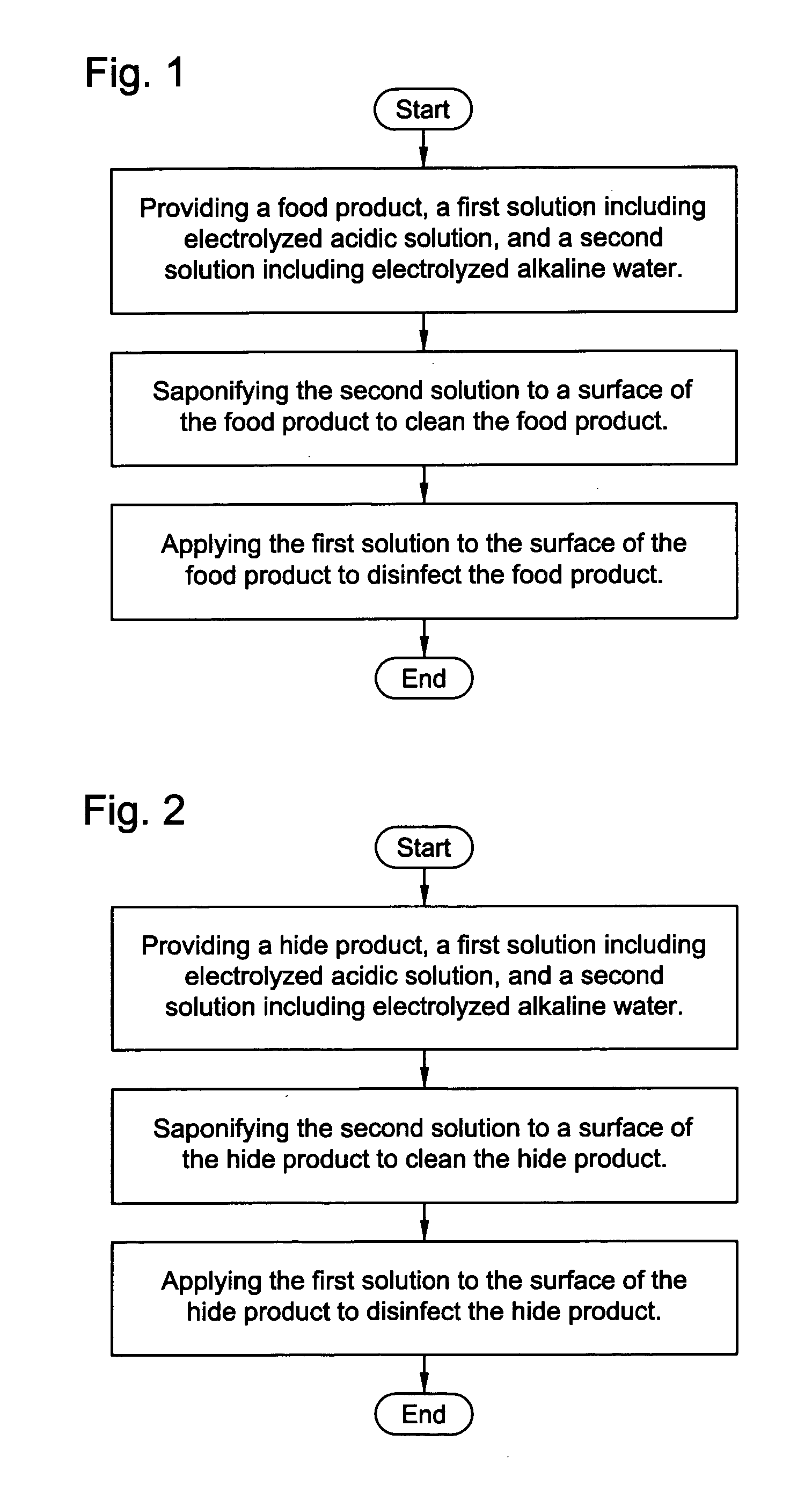Electrolyzed water treatment for meat and hide
a technology of electrolyzed water and meat, which is applied in the field of cleaning and disinfection, can solve the problems of toxic and environmentally harmful, chlorine gas-activated water, and extremely toxic trisodium phosphate or acidified sodium chlorite, and can be used in meat/fish preservation using chemicals,
- Summary
- Abstract
- Description
- Claims
- Application Information
AI Technical Summary
Problems solved by technology
Method used
Image
Examples
example 1
[0020]
Reduction of E. coli 015:H7 on cold-storedmeat fat from Sunland meatReductionTreatment(Log10 CFU / cm2)25° C. Deionized water dip0.4725° C. Acidic EO water (Type A solution) dip0.7125° C. Alkaline EO water (Type B solution) dip0.5225° C. Alkaline EG water dip followed by acidic EO0.74water dip (B + Type A solution)
[0021] The parameters for Example 1 are as follows. The initial population for the test was 4.76 Log 10CFU / cm2. EO water was produced using an EO water generator from Electric Aquagenics Unlimited (EAU) at 3.6 A setting. The acidic EO water utilized contained 73 mg / L chlorine. The dip treatment was conducted by immersing individual slices of meat fat tissue (2-4 inches) in 200 ml of treatment solution for 60 seconds with gentle hand shaking. One series of results is shown by the resulting Reduction (Log 10 CFU / cm2) that is apparent from the table. In the Examples, an increase in the value for the Reduction (Log 10 CFU / cm2) means an increase in the amount of pathogens o...
example 2
[0022]
Reduction of E. coli 0157:H7 on warm fat duringtransportation but reduced to room temperatureduring inoculation, holding, and treatmentReductionTreatment(Log10 CFU / cm2)24° C. Deionized water dip0.3224° C. EO water dip0.7958° C. EO water dip1.0324° C. Deionized water spray1.5024° C. EO water spray2.3858° C. EO water spray2.18
[0023] The parameters for Example 2 are as follows. The initial population was 6.07 Log 10CFU / cm2. The acidic EO water utilized contained 77 mg / L chlorine. The dip treatment was conducted by immersing individual slices of meat fat tissue (6 inches diameter circular share) in 200 ml of treatment solution for 60 seconds with gentle hand shaking. The spray treatment was conducted by spraying treatment solution at 80 psi for 60 seconds with a distance of 8.5 cm. The total amount of treatment solution applied was 1300 ml. The results shown by the Reduction (Log 10 CFU / cm2) are apparent from the table. One series of results is shown by the resulting Reduction (Lo...
example 3
[0024]
Reduction of E. coli 0157:H7 on warm fat during transportation,inoculation, holding, and treatmentReductionTreatment(Log10 CFU / cm2)24° C. Deionized water dip0.9924° C. EO water dip1.3062° C. EO water dip1.9824° C. Deionized water spray1.3124° C. EO water spray1.6462° C. EO water spray3.79
[0025] The parameters for Example 3 are as follows. The initial population was 6.42 Log 10CFU / cm2. The acidic EO water utilized contained 81 mg / L chlorine. The dip treatment was conducted by immersing individual slices of meat fat tissue (6 inches diameter circular share) in 200 ml of treatment solution for 60 seconds with gentle hand shaking. The spray treatment was conducted by spraying treatment solution at 80 psi for 60 seconds with a distance of 8.5 cm. The total amount of treatment solution applied was 1300 ml. One series of results is shown by the resulting Reduction (Log 10 CFU / cm2) that is apparent from the table. In the Examples, an increase in the value for the Reduction (Log 10 CFU...
PUM
| Property | Measurement | Unit |
|---|---|---|
| Fraction | aaaaa | aaaaa |
| Fraction | aaaaa | aaaaa |
| Electric potential / voltage | aaaaa | aaaaa |
Abstract
Description
Claims
Application Information
 Login to View More
Login to View More - R&D
- Intellectual Property
- Life Sciences
- Materials
- Tech Scout
- Unparalleled Data Quality
- Higher Quality Content
- 60% Fewer Hallucinations
Browse by: Latest US Patents, China's latest patents, Technical Efficacy Thesaurus, Application Domain, Technology Topic, Popular Technical Reports.
© 2025 PatSnap. All rights reserved.Legal|Privacy policy|Modern Slavery Act Transparency Statement|Sitemap|About US| Contact US: help@patsnap.com


